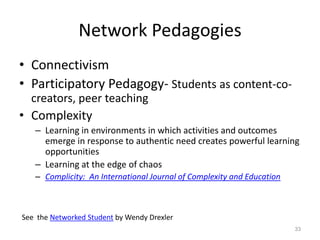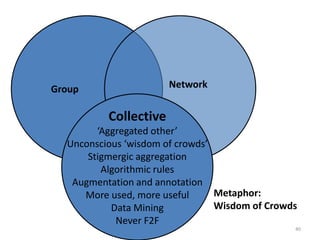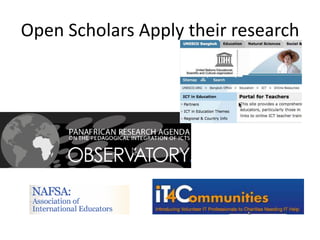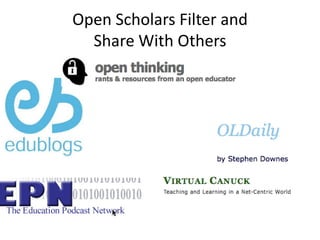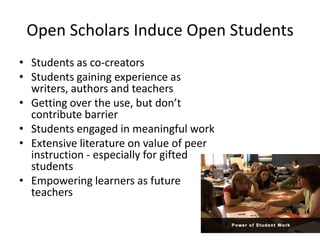Terry Anderson Alt C Final
- 1. Association for Learning TechnologyManchester, UK, 8-10 September 2009Terry Anderson, Ph.D.Canada Research Chair in Distance Education
- 2. IntroductionTerry Anderson’s CV in Wordle Tag Cloud
- 4. Anderson & Anderson,( submitted for publication)
- 5. Presentation OverviewBrief scan of the environmentTaxonomy of the ManyThe Open Scholar
- 6. ValuesWe can (and must) continuously improve the quality, effectiveness, appeal, cost and time efficiency of the learning experience.Student control and freedom is integral to 21st Century life-long education and learning.Education for elites is not sufficient for planetary survival.
- 7. Harmonizing Disruptive Technologies“Managing and aligning pedagogical, technical and administrative issues is a necessary condition of success when using emerging technologies for learning”But it takes leadership and disruptionGregor Kennedy et al. , Melbourne Educating the Net Generation: A Handbook of Findings for Practice and Policy , 2009
- 8. Recent history of Higher education InnovationLast systemic innovation was the emergence of the community colleges and open and alternative colleges of the 1960’sLast 40 years of reform:Examples: Problem based learning, faculty development, community, collaborative, technology enhanced learningPeripheral and outside of main stream rewards and strategic planning“ We can no longer pursue an add-on approach to the changing faculty role” Rice, Eugene. (2006). From Athens and Berlin to LA: Faculty Work and the New Academy
- 9. Promising SignsUbiquity and multi-functionality of web 2.0Growth of openness and online resources, OERsIncreasingly effective pedagogical models and learning activitiesReal educational alternatives – including private sectorDeath and retirement
- 10. Aligning with 21 Century studentsStudents are NOT deeply digitally engaged, empowered, nor skilled and certainly not homogeneous But they “arrive at college with well-established methods of sorting, doubting, and ignoring”“odd kind of student — one who appears polite and dutiful but who cares little about the course work, the larger questions it raises, or the value of living an examined life” Tom Clysdale, 2009 Wake Up and Smell the New EpistemologyOr is the life that we examine in formal education?We can no longer maintain interest and enthusiasm based on respect and superior knowledge
- 11. Net presence means Creating and Sustaining Social Capital“Relationships, more than information, determine how problems are solvedor opportunities exploited.” p. 17 Looi2001)
- 12. Choosing the righttool(s)?VLEhttp://www.go2web20.net over 3000 apps 12
- 13. Taxonomy of the ‘Many’ – A Conceptual ModelDron and Anderson, 2007GroupConscious membershipLeadership and organizationCohorts and pacedRules and guidelinesAccess and privacy controlsFocused and often time limitedMay be blended F2FMetaphor : Virtual classroom13
- 14. Formal Learning and GroupsLong history of research and studyEstablished sets of toolsClassrooms,VLEsSynchronous (F2F, video & net conferencing)EmailNeed to develop face to face, mediated and blended group learning skillsGarrison and Anderson, 2001
- 15. Critical Tools for Group Learning EnvironmentsCollaborative toolsDocument creation, management, versioningTime lines, calendars, Strong notificationsSecurity, trust hosting on institutional space?Behind firewalls, away from search enginesDecision making and project management toolsSynchronous and asynchronous conversations/meetings
- 16. Groups as Communities of PracticeWengler’s ideas of Community of Practicemutual engagement – synchronous and notification tools joint enterprise – collaborative projects, “pass the course”a shared repertoire – common tools, VLEs, IM and doc sharing
- 17. Online communities are a means to help preserve and continue the interests, knowledge and culture of a group bound by common interests. Looi, C. K. (2001)Looi, C. K. (2001). Enhancing learning ecology on the Internet Journal of Computer Assisted Learning, 17(1), 13-20
- 18. Distributed web 2.0 Group Tools
- 19. Problems with GroupsRestrictions in time, space, pace, & relationship - NOT OPENOften overly confined by teacher expectation and institutional curriculum controlUsually Isolated from the authentic world of practice“low tolerance of internal difference, sexist and ethicized regulation, high demand for obedience to its norms and exclusionary practices.” Cousin & Deepwell 2005Group think (Baron, 2005)Poor preparation for Lifelong Learning beyond the courseRelationshipsPaulsen (1993)Law of Cooperative Freedom
- 20. From Groups to Flocks ?? Michael WeschDo groups still only make sense in education?
- 21. Frontiers of Group LearningFrom systems designed to tack, control and lead learners, to systems designed to motivate and inspire learning.What motivates learners?Personal and social relevance
- 22. Opportunity to do well and be recognized
- 23. Chance to meet cool people and engage in cool activities
- 25. Rewards - formal education’s last strategic advantage Frontier College Archives
- 26. Groups SummaryGroups are necessary, but not sufficient for quality learning
- 27. GroupNetworkShared interest/practiceFluid membershipFriends of friendsReputation and altruism drivenEmergent norms, structuresActivity ebbs and flowsRarely F2FMetaphor: Virtual Community of Practice23
- 28. Networks add diversity to learning“People who live in the intersection of social worlds are at higher risk of having good ideas” Burt, 2005, p. 90
- 29. Collaborative Learning In GroupsCooperative Learning in Networks (Paulsen, 2008)Compelling, not compulsory activities
- 31. Google Wave ??
- 32. Communities of Practice NetworksDistributedShare common interestSelf organizinglooser aggregation defined by a range of loose and tight links No expectation of meeting or even knowing all members of the NetworkLittle expectation of reciprocityContribute for social capital, altruism and a sense of improving the world/practice through contribution(Brown and Duguid, 2001)
- 33. TransparencyThe ability to view and share thoughts, actions, resources, ideas and interests of others.“radically increase learner awareness of others’ learning activities in the PLE” Marc van Harmelen Manchester PLEDalsgaard, C., & Paulsen, M. (2009) Transparency in Cooperative Online Education
- 34. Major Challenges in Creating Incentives to Sustain Contribution to NetworksThe New Yorker September 12, 2005
- 35. "the network contains within it antagonistic clusterings, divergent sub-topologies, rogue nodes" Galloway and Thacker, 2007 p. 34 “There is crack in everything, that's how the light gets in” Leonard Cohen Image from http://www.flickr.com/photos/eeblet/423397690/
- 36. Connectivist Learningemergent practice, rather than prescribed education.Helping and scaffolding students to construct, connect, explore and mash resources and people to create contexts, that induce learning.George Siemens
- 37. Network Pedagogies33ConnectivismParticipatory Pedagogy- Students as content-co-creators, peer teachingComplexity Learning in environments in which activities and outcomes emerge in response to authentic need creates powerful learning opportunitiesLearning at the edge of chaosComplicity: An International Journal of Complexity and Education See the Networked Student by Wendy Drexler
- 40. Network Tool Set (example)t36Stepanyan, Mather & Payne, 2007
- 41. Access Controls in Elgg
- 42. Voicethread.com
- 43. Network Learning EnvironmentSummaryCooperative versus collaborativeCompelling but optional interactionPersistenceTransparencyFinding, building and enriching connections inside and outside of the “course”
- 44. Group NetworkCollective‘Aggregated other’Unconscious ‘wisdom of crowds’Stigmergic aggregationAlgorithmic rulesAugmentation and annotationMore used, more usefulData MiningNever F2FMetaphor: Wisdom of Crowds40
- 45. Formal Education and Collectives41“a kind of cyber-organism, formed from people linked algorithmically…it grows through the aggregation of Individual, Group and Networked activities” Dron & Anderson, 2007Collectives used to aggregate, then filter, compare, contrast and recommend.Personal and collaborative search and filter for learningAllows discovery and validation of norms, values, opinion and “ways of understanding”Educational semantic web“They follow not the logic of the network but of the set. They are aggregations that appear in some ways as a single entity” Dron & Anderson, 2009.On the Design of Collective Applications
- 46. AggregationData MiningOnlineActionsFilter & Select
- 49. GroupsNetworksTaxonomy of the ManyCollectivesDron and Anderson, 2007
- 50. Personal Learning Environments Easy to use Personally configurableGadgets, widgetsPush and pull dataMultiple machines, portableReflective spaces, Creating net presence and social capital
- 51. Dron & Anderson, 2008
- 52. Social Learning 2.0 Applications in Educational Contexts
- 54. Open Scholar“the Open Scholar is someone who makes their intellectual projects and processes digitally visible and who invites and encourages ongoing criticism of their work and secondary uses of any or all parts of it--at any stage of its development”. Gideon Burton Academic Evolution Blog
- 55. Open Scholars Create:A new type of education work maximizing:Social learningMedia richnessParticipatory and connectivist pedagogiesUbiquity and persistenceOpen data collection and research processCreating connections
- 56. Open Scholars Use and Contribute Open Educational ResourcesBecause it saves time!!!
- 58. Open Scholars Self ArchiveQuality scholarship is peer and public reviewed, accessible, persistent syndicated, commented and transparent.
- 59. Open Scholars Apply their research
- 60. Open Scholars do Open ResearchOpen Notebook: a laboratory notebook that is freely available and indexed on common search engines. …it is essential that all of the information available to the researchers to make their conclusions is equally available to the rest of the world.—Jean-Claude Bradley
- 61. Open Scholars Filter and Share With Others
- 62. Open Scholars support emerging Open Learning alternatives
- 63. Open Scholars Publish in Open Access JournalsOpen Access Journals have increased citation ratings:Work in progress with Olaf Zawacki-Richter, Ferne University, GermanyAnalysis of Google citations for 12 Distance Education Journals (using Harzing’s Publish or Perish tool)6 open access, 6 commercially publishedEarly results show roughly equal citations/paper, but recent gains in citations by open access journals
- 64. Open Scholars Create Open Access BooksUpcoming Emerging Technologies in DE edited by George Veletsiano
- 65. Open Scholars comment openly on the works of othersBookmarking and Annotation add valueCite-u-like, Brainify, Diigo, Delicious etcVLE additions like Margenalia.
- 66. Open Scholars Build Networks
- 67. Open Scholars Lobby for Copyright ReformSource: swiss-copyright.ch
- 68. Open Scholars Assign Open Textbooks
- 69. Open Scholars Induce Open StudentsStudents as co-creatorsStudents gaining experience as writers, authors and teachersGetting over the use, but don’t contribute barrierStudents engaged in meaningful workExtensive literature on value of peer instruction - especially for gifted studentsEmpowering learners as future teachers
- 70. Open Scholars support Open Students OpenStudents.Org
- 71. Open Scholars Teach Open CoursesGeorge Siemens & Stephen DownesIntroduction au technologieémergentesDave CormierAlec CuorosOpen Access Course: Social Media & Open Education (Fall 2009)
- 72. Open Scholars Research Openness
- 73. Open Scholars are Change Agents Open scholars develop tools and techniques to help cross-pollination, sustain and grow effective learning networks.From (Looi 2001).
- 74. Open Scholars Battle with TimeSave Time by using the efforts of othersI haven’t got the time to save!
- 75. Open Scholars are Involved in the FutureThrough personal experience we forge an ecology of lifelong learning.
- 76. Conclusion“Open Access is more than a new model for scholarly publishing, it is the only ethical move available to scholars who take their own work seriously enough to believe its value lies in how well it engages many publics and not just a few peers.” Gideon Burton, Academic Evolution Blog
- 77. Slides available on CrowdVinehttp://altc2009.alt.ac.uk/attachments/0000/4595/ALT-C_Final.pptxYour comments and questions most welcomed!Terry Anderson terrya@athabascau.caHomepage: http://cde.athabascau.ca/faculty/terrya.phpBlog: terrya.edublogs.org
Editor's Notes
- So this new epistemology produces a rather odd kind of student — one who appears polite and dutiful but who cares little about the course work, the larger questions it raises, or the value of living an examined life. And it produces such students in overwhelming abundance. Tim ClydesdaleWe need to teach as if our students were colleagues from another department.

































